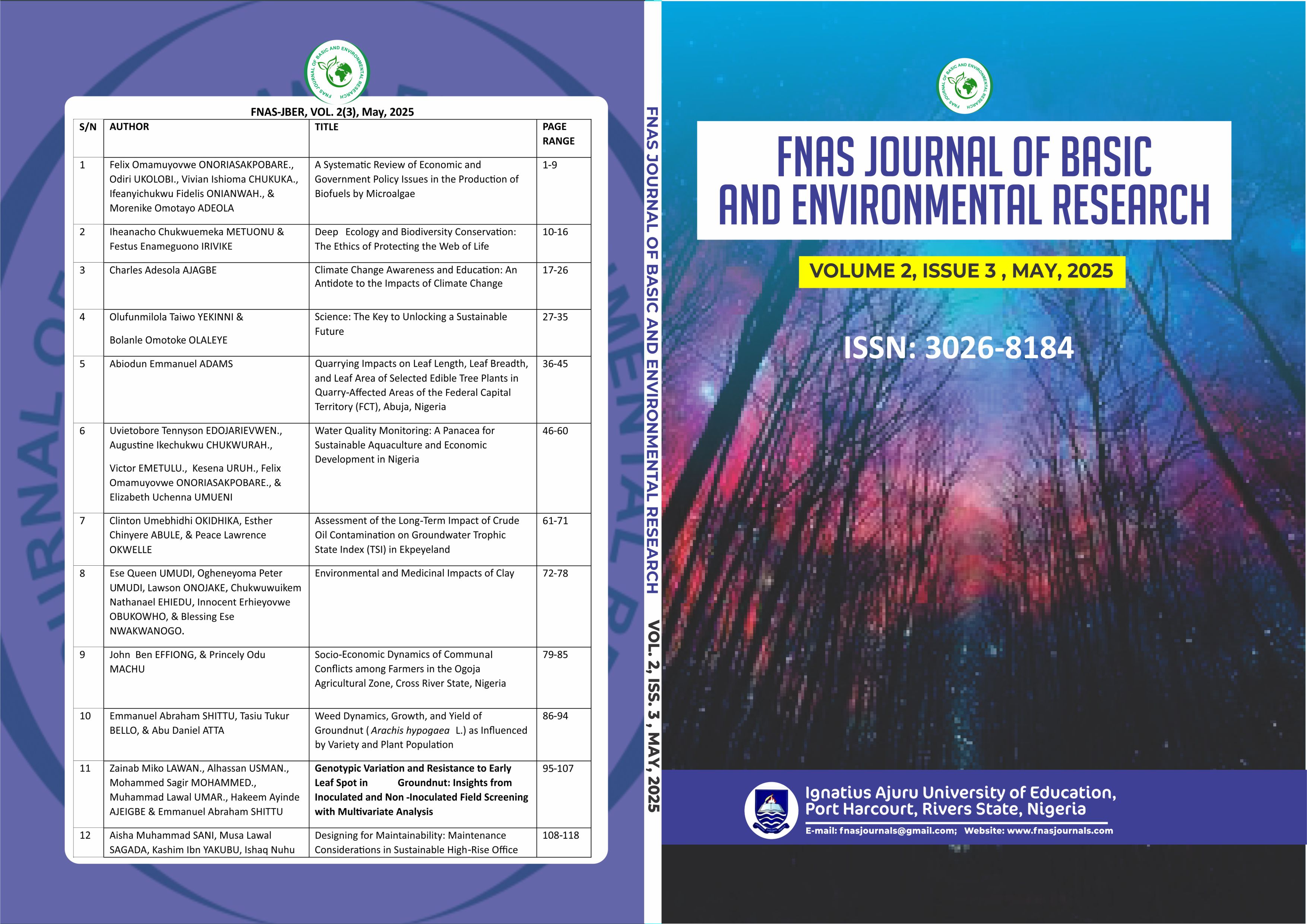Science: The Key to Unlocking a Sustainable Future
DOI:
https://doi.org/10.63561/jber.v2i3.823Keywords:
Background Knowledge, Future, Science, Sustainability, TechnologyAbstract
In today’s globally interconnected and rapidly evolving world, science and technology literacy is essential for individuals to thrive professionally and in everyday life. Science drives innovation and provides sustainable solutions to global challenges. However, despite its significance, many young people are drifting away from studying science, even as their engagement with modern technology increases. This study examined the scientific background knowledge of young people and their interaction with contemporary technology. A survey design of the ex-post facto type was used, as the variables were not manipulated. The target population comprised students in higher institutions across two educational districts in Lagos State, from which 1,250 participants were randomly selected. Data were gathered using a validated and highly reliable (r = 0.98) adapted questionnaire measuring science knowledge and technology use. Descriptive statistics (frequencies, percentages, means and standard deviations) were used for analysis. Results revealed an average science background knowledge score of 52.07% and a weighted mean technology engagement score of 3.22. The study recommends that national policy should prioritise science education to promote lifelong learning and support the development of a knowledge-driven, globally connected society.
References
Atkinson, R. D., & Mayo, M. (2010). Refuelling the US innovation economy: Fresh approaches to science, technology, engineering and mathematics (STEM) education. Washington, DC. The Information Technology and Innovation Foundation.
Ayodele, O. T., Balogun, S. A., & Ogunwale, Y. E. (2008). Influence of background in science subjects on students in Colleges of Education usage of Information and Communication Technology. Osun Journal of Science Education and Practice 5 (1), 60 – 67.
Cooke, J., & Hilton, M. L. (2015). Enhancing the quality of life and future public health through scientific research. Emerging Infectious Diseases, 21(9), 1487-1492.
Diallo, A. B. (2004). Education today: Science education in danger. The Newsletter of UNESCO’S Education Sector. No 11, October-December.
European Commission (2015). Science education for responsible citizenship. Luxembourg. Publications Office of the European Union
Fauci, A. S., & Lane, H. C. (2005). The importance of science in training physicians for the 21st century. Academic Medicine, 80(11), 977-978.
Federal Republic of Nigeria (2016). National Policy on Education, 6th Edition. Lagos
Food and Agriculture Organization of the United Nations (FAO). (2019). The future of food and agriculture: Trends and challenges. Rome: FAO www.fao.org (ISSN 2522 – 722X)
Godfray, H. C. J., Beddington, J. R., Crute, I. R., Haddad, L., Lawrence, D., Muir, J. F., & Toulmin, C. (2010). Food security: the challenge of feeding 9 billion people. Science, 327(5967), 812-818. DOI: https://doi.org/10.1126/science.1185383
Hall-Rose, J. (2004). Education Today: Science Education in danger. The Newsletter of UNESCO’S Education Sector. No 11, October-December.
Intergovernmental Panel on Climate Change (IPCC) report “Climate Change” (2021). The Physical Science Basis. Cambridge, UK. Cambridge University Press www.ipcc.ch
Laugksch, R. C. (2000). Scientific literacy: A conceptual overview. Science Education, 84(1), 71-94. DOI: https://doi.org/10.1002/(SICI)1098-237X(200001)84:1<71::AID-SCE6>3.0.CO;2-C
Lederman, N. G. (2007). Nature of science: Past, present and future. In Handbook of Research on Science Education (pp. 831-879). Routledge.
Mokyr, J. (2018). The contribution of scientific and technological innovation to economic growth. In The Economics of Science (pp. 11-34). Springer, Singapore.
National Aeronautics and Space Administration, NASA. (2021). Science for a sustainable future. https://climate.nasa.gov/news/3120/science-for-a-sustainable-future/
National Research Council (2015). Guide to Implementing the Next Generation Science Standards. Washington, DC: The National Academies Press. https://doi.org/10.17226/18802. DOI: https://doi.org/10.17226/18802
National Research Council, NRC (2012). A Framework for K-12 Science Education: Practices, Crosscutting Concepts and Core Ideas. National Academies Press.
National Research Council, NRC (2021). Call to Action for Science Education: Building Opportunity for the Future. Washington, DC: The National Academies Press. https://nap.nationalacademies.org
Nisbet, M. C. & Scheufele, D. A. (2009). What's next for science communication? Promising directions and lingering distractions. American Journal of Botany, 96(10), 1767-1778. DOI: https://doi.org/10.3732/ajb.0900041
Pachauri, R. K. & Meyer, L. A. (Eds.) (2014). Climate change 2014: Synthesis report. Contribution of Working Groups I, II and III to the Fifth Assessment Report of the Intergovernmental Panel on Climate Change. IPCC.
Robbert, K. (2005). Communication Technology in Education and Training; Downloaded on September 28th 2008.
Sjeberg, S. (2004). Education Today: Science Education in danger. The Newsletter of UNESCO’S Education Sector. No 11, October-December.
Tilman, D., Balzer, C., Hill, J., & Befort, B. L. (2011). Global food demand and the sustainable intensification of agriculture. Proceedings of the National Academy of Sciences, 108(50), 20260-20264. DOI: https://doi.org/10.1073/pnas.1116437108
United Nations. (2022). The role of science, technology and innovation in achieving sustainable development. https://sdgs.un.org/topics/science-technology-and-innovation
Valley, E. A., & Withier, C. A. (2009). Integrated Science Program. Learn Science In months Not Years. Southern. Califonia University of Health Sciences.
Zerubabel, N. (2004). Education Today: Science Education in danger. The Newsletter of UNESCO’S Education Sector. No. 11, October-December.





